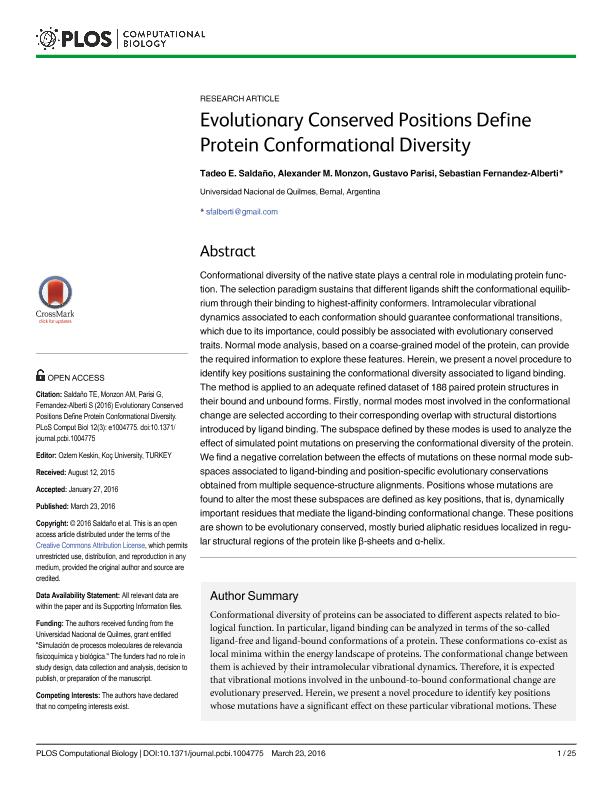Artículo
Evolutionary Conserved Positions Define Protein Conformational Diversity
Fecha de publicación:
03/2016
Editorial:
Public Library of Science
Revista:
Plos Computational Biology
ISSN:
1553-734X
Idioma:
Inglés
Tipo de recurso:
Artículo publicado
Clasificación temática:
Resumen
Conformational diversity of the native state plays a central role in modulating protein function. The selection paradigm sustains that different ligands shift the conformational equilibrium through their binding to highest-affinity conformers. Intramolecular vibrational dynamics associated to each conformation should guarantee conformational transitions, which due to its importance, could possibly be associated with evolutionary conserved traits. Normal mode analysis, based on a coarse-grained model of the protein, can provide the required information to explore these features. Herein, we present a novel procedure to identify key positions sustaining the conformational diversity associated to ligand binding. The method is applied to an adequate refined dataset of 188 paired protein structures in their bound and unbound forms. Firstly, normal modes most involved in the conformational change are selected according to their corresponding overlap with structural distortions introduced by ligand binding. The subspace defined by these modes is used to analyze the effect of simulated point mutations on preserving the conformational diversity of the protein. We find a negative correlation between the effects of mutations on these normal mode subspaces associated to ligand-binding and position-specific evolutionary conservations obtained from multiple sequence-structure alignments. Positions whose mutations are found to alter the most these subspaces are defined as key positions, that is, dynamically important residues that mediate the ligand-binding conformational change. These positions are shown to be evolutionary conserved, mostly buried aliphatic residues localized in regular structural regions of the protein like β-sheets and α-helix.
Palabras clave:
CONFORMATIONAL DIVERSITY
,
PROTEINS
,
EVOLUTION
,
DYNAMICS
Archivos asociados
Licencia
Identificadores
Colecciones
Articulos(SEDE CENTRAL)
Articulos de SEDE CENTRAL
Articulos de SEDE CENTRAL
Citación
Saldaño, Tadeo Enrique; Monzón, Alexander; Parisi, Gustavo Daniel; Fernández Alberti, Sebastián; Evolutionary Conserved Positions Define Protein Conformational Diversity; Public Library of Science; Plos Computational Biology; 12; 3; 3-2016; 1-25
Compartir
Altmétricas




